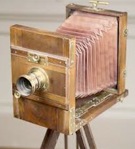As the holiday season approaches many will consider buying a new camera. However, with the advent of the all encompassing mobile telephone is one necessary? A similarly priced camera readily captures snow scenes, beach scenes, portraits, the family cat or dog and photographs friends only when they are smiling, all in brilliant colour. Little instruction is considered necessary. How different a hundred years ago.
“A traveller wishing to take photographs of scenery must first decide on the size of glass plate he intends to employ, be they 4 ¾ x 3 ¼ or 8 ½ x 6 ½ inches, although one can more readily utilise 7 ½ x 5 inch. In those countries where porters are cheap the largest format is preferred. Glass plates weigh in the region of 3 pounds per dozen and one should take at least half a gross (seventy-six, approximately 20 pounds). One might use gelatine film but glass is much to be preferred and film is not recommended for hot and humid climates.
The camera itself should be of the bellows form constructed of the finest mahogany, particularly those made by Mr. Meagher of Southampton Row or Mr. Hare of Calthorpe Street. It should have a front capable of moving vertically and horizontally, with a swing back. For normal photographs one may dispense with a tripod, however they can be useful under certain circumstances and readily purchased for 25 shillings (£1.25p). An appropriate socket will be provided in the camera along with a spirit level to ensure correct vertical and horizontal alingement.
In the field it will be necessary to have plates previously loaded in double backed holders, i.e. two plates per holder. A black light-proof bag is a necessity in which plates may be transferred safely from their original light proof packaging into the slide holders.
For cameras using 7 ½ x 5 inch plates a 9 inch lens is recommended for most subjects, Messrs Dallmeyer, Ross or Zeiss lenses should be considered. All available from respectable dealers such as Messrs. Watson and Son of High Holborn, Mr. Morley of Upper Street or Hunter & Sands of Cranbourne Street. Gelatine sheets are made in various degrees of sensitivity but their cardboard  boxes are insufficient protection against injury and damp. It is recommended to have each package of a dozen placed in fairly airtight light-proof wooden boxes; during construction screws are preferred to nails. After exposure Captain Abney recommends a cardboard frame be placed between each plate or film and placed in light wooden boxes prior to being packed in a tin box whereby the lid is soldered in place as protection against damp.
boxes are insufficient protection against injury and damp. It is recommended to have each package of a dozen placed in fairly airtight light-proof wooden boxes; during construction screws are preferred to nails. After exposure Captain Abney recommends a cardboard frame be placed between each plate or film and placed in light wooden boxes prior to being packed in a tin box whereby the lid is soldered in place as protection against damp.
A reasonable expense would be a camera for 8 guineas (£8.40p), 12 double slides at a guinea each, three lens of varying focal length approximately 15 guineas (£15. 75p), tripod 25 shillings (£1.25p). Gelatine sheets at three shillings (75p) a dozen. Chemicals 15/- (75p). A notebook in which to record each exposure, thereby to ensure correct development times later, and a sturdy box or basket to contain the whole. Due to the flexible nature of a basket a basket is preferred. Total weight approximately 60 pounds.”
From Hints to Travellers Volume II (Eighth Edition) published by The Royal Geographical Society in 1901. Edited for the Council of the Royal Geographical Society by John Coles F.R.G.S., F.R.A.S. Late Instructor in Surveying and Practical Astronomy to the Royal Geographical Society.
Happy snapping everyone! Roger Sugar.
___________________________________________________________
